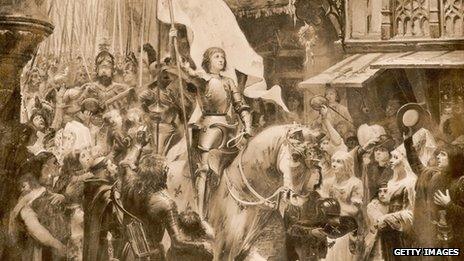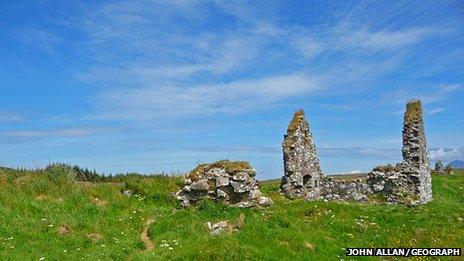Game of thrones: Scots' role in foreign power struggles
- Published

Scots fought alongside Joan of Arc in France
On Good Friday almost 500 years ago, Scots fought in a battle on Swedish soil in which their country was not involved. It was not an isolated case. Thousands of Scots have played a part in power struggles overseas for many centuries.
Lonely Planet describes Uppsala in modern-day Sweden as having the feel of a "small, green Amsterdam" with its picturesque waterways and droves of people on bicycles.
But in 2001, workmen making improvements to a path uncovered evidence of the old city's violent past. They uncovered a mass grave containing some of the thousands who fell at the Battle of Good Friday on 6 April 1520.
Archaeologists went on to recover the remains of about 60 men aged in their 20s and 30s. Their skulls and bones had cut marks showing where they had been struck by swords and other weapons.
The battle was fought during a war between Danish royalty and Swedish nobles over the union of the two countries.
At Uppsala, the Danes fielded an army of at least 6,000 - many of the foot soldiers were mercenaries contracted from Scotland, France and Germany - against a force of Swedish farmers.
The Danish army were victorious, but only after 2,000 of their men and many more Swedes had been killed.
Prof Neil Price, of the University of Aberdeen, has written about Uppsala for the Scottish Archaeological Research Framework, external.
He said it was not known where in Scotland they came from.
But he added that because of the high number of Scots sent into the battle it was possible that some of those laid in the mass grave uncovered in 2001 were Scots.
Prof Price said: "Without detailed analysis, such as isotope work on the skeletons' teeth, we are unlikely to know for sure whether the dead in the mass grave were from the Danish or Swedish armies.
"The care with which they were buried suggests that they might have been among the victor's casualties.
"If that is the case, the majority of the 'Danish' army was composed of Scottish mercenaries, so the Uppsala burial may very well be that of Scots who fell on Good Friday.
"On the other hand, it is clear from weathering on the bones that they had been exposed to the elements for some time and had presumably been left on the battlefield - which would imply that they belonged to the losers, the Swedes.
"I think we can be sure that they were either Scots, or people they killed," he added.
'Mists of time'
During the 16th and 17th centuries Scots mercenaries travelled to many parts of Europe including to the Netherlands where they fought with the Dutch, and in Belgium alongside Spaniards.
There were some notable figures from the west Highlands and Islands who fought with the Spanish in the early 17th Century.
They included Sir James MacDonald, Chief of Clan Donald South; Alasdair Mac Ranald, chief of the Macdonalds of Keppoch, and Archibald Campbell, the 7th Earl of Argyll.
The Hebrides - including the islands of Lewis and Mull - provided a rich resource in fighting men for these battles abroad.

From their base on Islay, the Lords of the Isles launched attacks and raids against the rest of Scotland
Archaeologist Dr David Caldwell said the islands had a long tradition of producing warriors.
He said: "One of the key things to understand is that society in the Hebrides in the medieval period was particularly militaristic."
These fighting men were at the command of the Lords of the Isles, who ran the west Highlands and Islands almost as a separate state from the rest of the Scotland until the 1490s.
Dr Caldwell said a late 16th Century document, among the earliest available records of what happened on the isles in the 1490s, appeared to show that the Hebrides would have been able to provide an army of 6,000 to 7,000 men.
The men fought a royal army at Harlaw, near Inverurie, in Aberdeenshire, in 1411. In 1452 Hebridean warriors raided royal lands around the Forth of Clyde.
Even after the collapse of the Lord of the Isles, Scottish islands continued to be a rich recruiting ground for fighting men.
Dr Caldwell said: "By the early 16th Century the Western Isles were supplying men to do fighting in Ireland.
"The main military contractors included the MacDonalds of Dunyvaig and the Glens - leaders of Clan Donald South - with lands concentrated in Islay and Kintyre, and the MacLeans of Duart in Mull.
"The Campbells were also significant players."
He added: "Ireland was a country fragmented right from the English invasion in the 12th Century. There was a lot of fighting, a lot of small kingdoms."
Rival leaders needed fighters and many were eager to "import" them from Argyll and the Hebrides, Dr Caldwell said.
Scottish warriors also helped to forge Scotland's Auld Alliance with France.
Between 1419 and 1424, 15,000 Scots left for France where they helped the French to defeat the English at the Battle of Bauge in 1421. An army of 4,000 Scots were later crushed at Vernuil.
Scots went on to fight alongside Joan of Arc and helped her to relieve besieged Orleans from English soldiers.
'Religious upheaval'
Prof Steve Murdoch, of the University of St Andrews, said Scots would fight overseas as conditions of alliances or for their religious beliefs.
He said: "Since the Middle Ages, there had been a Scottish body of soldiers in French service, the Garde Écossaise. They served as part of the conditions of the Auld Alliance.
"However, the religious upheaval of the post-1560 period informed the choice of destination for the military Scot.
"For sure, the Garde Écossaise was reduced to only a company, but still offered an outlet for the Catholic Scot to serve overseas without prejudicing their dynastic loyalty to the House of Stuart."
Prof Murdoch added: "With the outbreak of the Dutch Revolt in 1568, thousands of their Scottish brethren joined in support of their Protestant brethren in what was something of a Calvinist International.
"A force of 3,000 Scots, divided into three regiments, became collectively called the Scots Brigade and remained a permanent part of the Dutch military structure until the outbreak of the 4th Anglo-Dutch war in 1780. They fought under Scottish colours and remained the 'property' of the British monarch."
In later centuries, men from Scotland continued to play roles in military affairs overseas.
Patrick Gordon, a soldier of fortune born at Auchleuchries, near Ellon, external, instructed Russia's Peter the Great in tactics in the 17th Century.
In 1859, Thomas Blake Glover, external arrived in Nagasaki, Japan, to run an office for a British trading office.
After building up a business exporting tea, Glover went on to make his fortune selling ships and arms to both sides in a conflict between the ruling Tokugawa Shogunate and rebellious clans.
War-like Scots had come a long way from bashing heads at Uppsala.